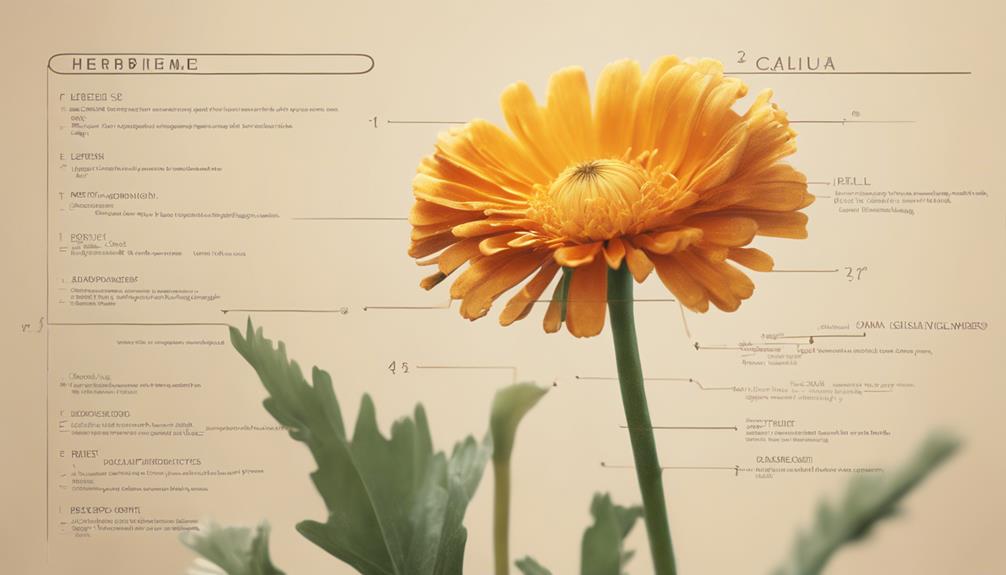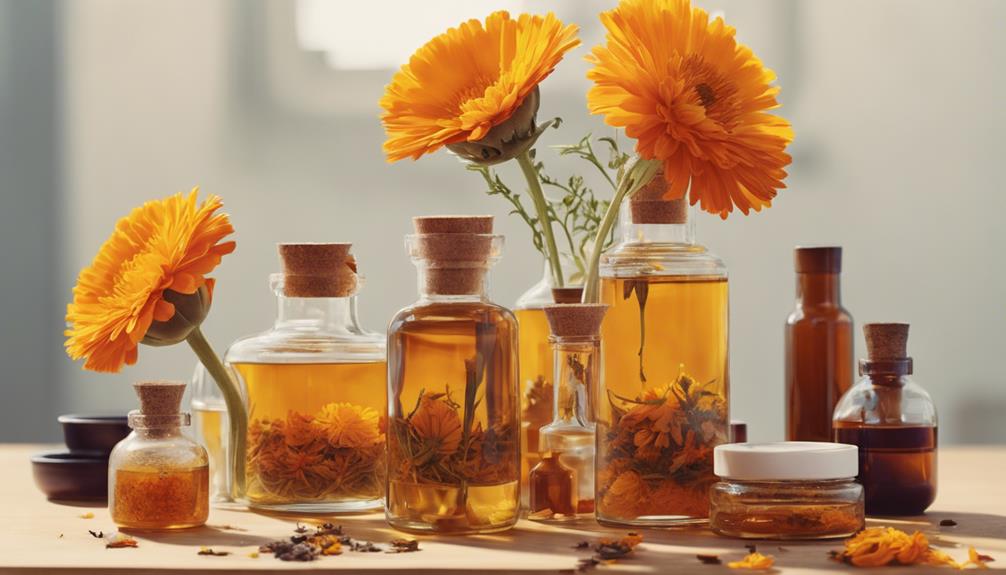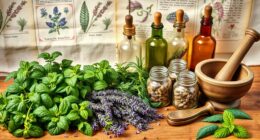We use the flowers and petals of the calendula plant in herbal remedies, which are rich in antioxidants and anti-inflammatory agents that provide therapeutic benefits for skin conditions and wound healing. These bright orange-yellow petals contain beneficial compounds, making them an effective treatment for wounds, burns, and skin conditions. The flowers and petals are the primary components utilized in herbal remedies, although leaves and stems have unique potential medicinal applications. As we explore the world of calendula, we'll uncover more about its medicinal uses, preparation methods, and potential interactions, uncovering the full potential of this versatile herb.
Key Takeaways
• Flowers and petals are the primary components used in herbal remedies, rich in antioxidants and anti-inflammatory agents.
• Leaves and stems have unique potential medicinal applications, often overlooked in favor of petals for therapeutic benefits.
• The bright orange-yellow petals contain beneficial compounds, making them ideal for topical application in herbal remedies.
• The flowers are used to make infused oils, tinctures, and ointments for healing and soothing skin conditions.
• The petals are used in topical applications, while the leaves and stems are used in teas and washes for internal healing and digestive support.
Plant Description and Characteristics
As we explore the world of herbalism, we discover that the calendula plant, with its bright orange-yellow petals, is a treasure trove of medicinal properties waiting to be revealed.
The plant's vibrant petals aren't just aesthetically pleasing, but they're also rich in compounds that contribute to its medicinal benefits.
In herbalism, the dried petals of the calendula plant are used for their medicinal properties, which are then applied topically to the skin to reap their benefits. This topical application allows the medicinal properties to be absorbed directly into the skin, making it an effective treatment for wounds, burns, and skin conditions.
The calendula plant's ability to heal and soothe the skin is unparalleled, making it a staple in herbal remedies.
As we dig deeper into the world of herbalism, we'll uncover more about the calendula plant's incredible properties and how they can be harnessed to improve our overall well-being.
Parts of Calendula Used Medicinally

As we explore the medicinal uses of calendula, we're interested in identifying the specific parts of the plant that are utilized for their therapeutic properties.
We'll examine the flowers and petals, which are the primary components used in herbal remedies, as well as the leaves and stems, which also have their own unique applications.
Flowers and Petals
We utilize the flowers and petals of the calendula plant in herbalism, as they're the primary parts used for their medicinal properties. These vibrant orange-yellow petals are rich in antioxidants and anti-inflammatory agents, making them a valuable component in herbal remedies.
The dried petals of calendula are commonly infused into oils, salves, and ointments for various healing purposes. The flowers contain beneficial compounds that are harnessed in herbal medicine practices. Calendula flowers are harvested and processed to reveal their healing benefits, which are then used to create medicinal products.
In herbalism, the flowers and petals are the most sought-after parts of the plant, and for good reason – they hold the key to accessing the plant's medicinal properties. By incorporating calendula flowers and petals into infused oil, salves, and ointments, herbalists can create effective remedies for a range of health issues.
As we explore the uses of calendula in herbalism, it becomes clear that the flowers and petals are the true stars of the show.
Leaves and Stems
While the vibrant petals of the calendula plant steal the spotlight in herbalism, we're now shifting our focus to the often-overlooked leaves and stems, exploring their potential medicinal applications.
Despite their abundance, calendula leaves and stems aren't commonly used in herbalism, as the focus is on the vibrant orange-yellow petals. These petals are rich in beneficial compounds that contribute to the plant's healing properties, making them the primary choice for medicinal applications. The dried petals are used to make tinctures, ointments, and washes, leveraging their therapeutic benefits.
In contrast, the leaves and stems of the calendula plant aren't traditionally used in herbalism, with the focus on the potent petals for their therapeutic benefits. As we investigate further into the potential uses of calendula, it's crucial to acknowledge the overlooked parts of the plant. Although they may not be as prominent, the leaves and stems may still hold secrets waiting to be uncovered, and further research could reveal their hidden medicinal applications.
Medicinal Uses and Health Benefits

We've used the dried petals of the calendula plant for medicinal purposes in herbalism, leveraging their potent healing properties. The orange-yellow petals of calendula flowers are valued for their medicinal benefits, primarily applied topically to the skin for their healing properties. Traditionally, calendula has been used for stomach upset, ulcers, and menstrual cramps. While scientific evidence for these traditional uses is limited, more research is needed to confirm its effectiveness.
Here's a breakdown of calendula's medicinal uses and health benefits:
| Medicinal Use | Health Benefit | Application Method |
|---|---|---|
| Stomach upset relief | Soothes digestive issues | Topical application |
| Skin healing | Accelerates wound healing | Topical application |
| Menstrual cramp relief | Eases menstrual discomfort | Topical application |
Calendula's medicinal uses are rooted in its anti-inflammatory and antimicrobial properties, making it a reliable traditional remedy. As we continue to explore the benefits of calendula, it's essential to acknowledge the need for further scientific evidence to support its traditional uses. By doing so, we can unlock the full potential of this versatile herb.
Available Forms and Preparations

Calendula is available in various forms and preparations that facilitate its medicinal uses, including tinctures, ointments, and washes for topical application.
We can use the dried petals of the calendula plant to create infused oils, which are then used in herbal remedies like calendula oil and salves. These preparations are used externally to promote wound healing, alleviate skin conditions, and provide anti-inflammatory benefits.
Additionally, calendula can be consumed as teas or washes to support digestive health and internal healing. The versatility of calendula allows it to be used in multiple ways, making it a valuable herb in herbalism.
How to Use Calendula Safely

As we explore how to use calendula safely, we'll examine the essential guidelines that guarantee we reap its benefits while minimizing potential risks.
We'll investigate the recommended dosage guidelines, potential interactions with medications or health conditions, and vital contraindications to be aware of.
Dosage Guidelines
When using calendula for medicinal purposes, we must adhere to specific dosage guidelines to ensure safe and effective treatment. As we explore the medicinal properties of calendula, understanding the importance of proper dosage is crucial to reap the benefits of its skin-soothing and wound-healing properties.
Here are some key guidelines to keep in mind:
- Topical application:
Calendula is typically applied topically for skin conditions and wound healing, so be sure to follow the recommended dosage for the specific form of calendula you're using (tea, oil, salve, etc.).
- Dosage recommendations:
Always follow the recommended dosage guidelines for the specific form of calendula you're using, and consult with a healthcare professional before use.
- Form of calendula:
The dosage guidelines vary based on the form of calendula used, so make sure to adjust accordingly.
- Healthcare professional consultation:
Consult with a healthcare professional before using calendula, especially if you have any underlying health conditions or allergies.
Potential Interactions
We need to be mindful of potential interactions and side effects when using calendula to guarantee safe and effective treatment. As with any herbal remedy, it's important to take into account potential allergic reactions, especially for individuals with allergies to plants in the Asteraceae family. Pregnant women should exercise caution due to calendula's alleged menstrual effects.
| Potential Interaction | Who's Affected | Precaution |
|---|---|---|
| Allergic Reactions | Individuals with Asteraceae allergies | Exercise caution |
| Menstrual Effects | Pregnant women | Avoid use |
| Interaction with Sedatives and Blood Pressure Meds | Those taking sedatives or blood pressure medications | Consult a healthcare provider |
Calendula may interact with sedatives and blood pressure medications, so it's essential to consult a healthcare provider before use. Although the FDA considers calendula safe for general use, we must be aware of these potential interactions and side effects. By being informed, we can ensure safe and effective treatment with calendula.
Contraindications Warning
We'll take a closer look at the specific guidelines for safe usage to minimize the risk of adverse effects. When using calendula, it's essential to exercise caution to avoid any potential contraindications.
Here are some key considerations to keep in mind:
- Pregnant women: Calendula should be avoided due to its alleged effects on menstruation.
- Allergic reactions: Individuals with allergies to the Asteraceae family may experience reactions with skin contact.
- Interactions: Calendula may interact with sedatives and blood pressure medications, so caution is advised when using it.
- Topical use: While generally safe for topical use, calendula may still cause allergic reactions in some individuals.
Possible Interactions and Contraindications

As we explore the therapeutic benefits of calendula, it's important to acknowledge its potential interactions and contraindications to guarantee safe and effective use.
We must exercise caution when using calendula alongside certain medications, such as sedatives and blood pressure medications, as interactions may occur. Additionally, individuals with sensitivities to the Asteraceae family plants may experience allergic reactions with skin contact to calendula.
Pregnant women, in particular, should avoid calendula due to its alleged effects on menstruation, making it potentially unsafe during pregnancy. While the FDA generally considers calendula safe for use, we should still be aware of potential allergic reactions and interactions with medications.
With a long history of traditional use in herbalism, it's important to consult with a healthcare provider before using calendula, especially if you have allergies or are pregnant.
Growing and Harvesting Calendula Flowers

Sowing calendula seeds in well-draining soil and providing full sun sets the stage for a bountiful harvest of medicinal flowers. We're excited to share our knowledge on growing and harvesting calendula flowers, the part of the plant used in herbalism for their medicinal properties.
Growing calendula involves more than just sowing seeds; it requires attention to detail to guarantee ideal growth. Here are some essential tips to keep in mind:
- Sow seeds in well-draining soil: Calendula thrives in soil that drains excess water, preventing root rot.
- Provide full sun: Calendula needs at least 6 hours of direct sunlight to promote healthy growth.
- Harvest every 2-3 days: Picking flowers regularly encourages continuous blooming.
- Harvest in the heat of the day: This ensures excellent drying of the petals, perfect for herbal preparations.
Proper harvesting of calendula flowers is vital to preserve their medicinal properties. By following these guidelines, we can enjoy a bountiful harvest of dried petals, perfect for incorporating into herbal preparations like oils, salves, and teas.
Research and Studies on Calendula

We've explored the world of growing and harvesting calendula flowers, now it's time to examine the research and studies that support their medicinal properties. The scientific community has been actively studying the topical use of calendula petals for medicinal purposes, particularly in wound healing and skin conditions.
| Studies on Calendula | Findings |
|---|---|
| Topical application on wounds | Accelerated wound healing and reduced inflammation |
| Anti-inflammatory and antimicrobial properties | Confirmed through scientific evidence |
| Oral consumption | Limited research, but topical applications show promising results |
| Ongoing research | Continues to validate calendula's medicinal uses and potential benefits |
Studies suggest that calendula's dried petals are effective in wound healing and skin conditions, thanks to its anti-inflammatory and antimicrobial properties. While research on oral consumption is limited, topical applications have shown promising results in various skin ailments. As scientific studies on calendula's medicinal uses continue, we can expect further validation of its effectiveness and potential benefits in herbalism.
Frequently Asked Questions
What Part of the Calendula Flower Do You Use?
When it comes to using calendula for medicinal purposes, we're often asked what part of the flower is utilized.
The answer lies in the dried petals, which contain the active compounds responsible for the plant's healing properties.
We use these orange-yellow petals to create tinctures, ointments, and washes that provide therapeutic benefits when applied topically to the skin.
How to Prepare Calendula for Medicinal Use?
We often assume that preparing calendula for medicinal use is a complicated process, but it's actually quite straightforward.
To start, we harvest and dry the petals to preserve their potency.
Then, we can infuse them into oils, salves, tinctures, or teas to create topical applications or herbal remedies.
What Part of Calendula Is Used for Salve?
We're often asked what part of the calendula flower is used to create those amazing healing salves. Well, it's the petals that hold the magic.
Rich in medicinal properties, they're infused into oils to create potent salves that soothe and heal skin irritations.
What Parts of Calendula Are Edible?
'When in doubt, throw it out' – we're glad we can clarify the edible parts of calendula for you.
We're excited to share that the petals of the calendula plant aren't only used in herbalism but are also edible! They can add a pop of color and nutrients to dishes like salads and herbal compound butters.
Conclusion
In our exploration of calendula, we've uncovered the versatility of this yellow-petaled flower. We've seen how its flowers, leaves, and stems are used in herbalism to treat skin issues, wounds, and even anxiety.
Let's not forget the remarkable case of a 3-year-old boy who, after suffering from severe eczema, found relief through topical calendula cream applications.
As we conclude, we're reminded that nature's remedies, like calendula, can bring hope and healing to those in need.










